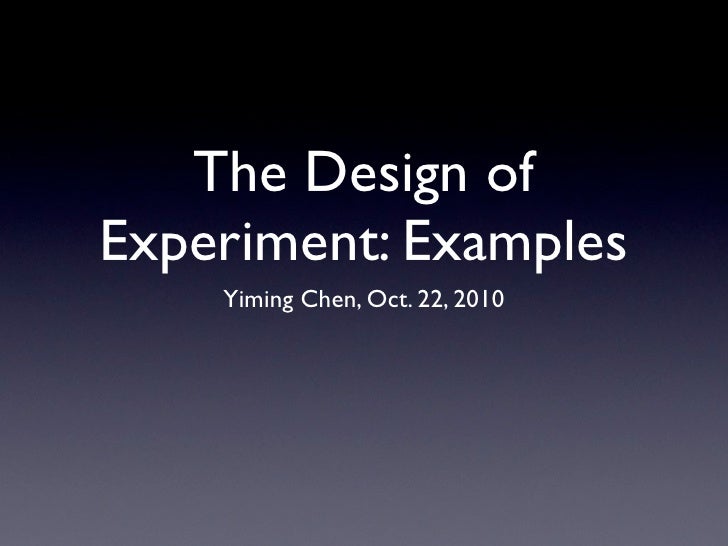Table Of Content

This section reviews notable statistical software packages that support DoE, highlighting features that enhance the research process from design to data visualization. Response Surface Methodology (RSM) is an advanced set of techniques for modeling and analyzing problems in which several variables influence a response of interest. RSM is designed to optimize the response, identify the relationship between variables, and find the conditions that maximize or minimize the response value. Truth in measurement is the cornerstone, demanding accuracy and reliability in data collection and analysis.
Identify the main effects of your factors
Goodness in methodology goes beyond the technical, embedding an ethical framework within which experiments are designed and conducted. It is a commitment to integrity, ensuring that the methods employed are both scientifically valid and morally sound, respecting the dignity of all participants and the sanctity of the natural world being studied. Participants will complete a project that is typically based around their own work environment, and can use this to effectively demonstrate the application of experimental design methodology.
Statistical significance
This includes measures such as mean, median, mode, range, and standard deviation. Physiological measures involve measuring participants’ physiological responses, such as heart rate, blood pressure, or brain activity, using specialized equipment. These measures may be invasive or non-invasive, and may be administered in a laboratory or clinical setting. This involves systematically varying the order in which participants receive treatments or interventions in order to control for order effects. In this design, each participant is exposed to all of the different treatments or conditions, either in a random order or in a predetermined order.
How to Conduct Your Own Conformity Experiments - Verywell Mind
How to Conduct Your Own Conformity Experiments.
Posted: Wed, 29 Nov 2023 08:00:00 GMT [source]
Trial-and-error method
The practice of Designing Experiments goes beyond mere data analysis; it is a philosophical commitment to enhancing the good by improving research methods and revealing the inherent beauty in data patterns. With each experiment designed, we step closer to insights that reflect the depth and richness of our reality, making DoE not just a technical necessity but a beacon of enlightenment in the scientific community. The Design of Experiments (DoE) landscape is rich with diverse strategies tailored to uncover specific insights within various research domains.
How long does it take to complete the Specialization?
So when students are recruited or choose to come to Columbia, they’re actively opting into a campus that prides itself on being an activist community. They consider the city and the world, really, like a classroom to Columbia. Time series analysis is used to analyze data collected over time in order to identify trends, patterns, or changes in the data. SEM is a statistical technique used to model complex relationships between variables. It can be used to test complex theories and models of causality.
This design is handy when the experimental units have an inherent variability that could affect the treatment outcome. Together, these principles and ethical considerations create a framework for DoE that is robust, respectful, and reflective of the highest ideals of scientific inquiry. They ensure that experiments designed are technically sound, ethically grounded, and philosophically aligned with pursuing a deeper understanding of the world. Second, you may need to choose how finely to vary your independent variable. Sometimes this choice is made for you by your experimental system, but often you will need to decide, and this will affect how much you can infer from your results. You manipulate one or more independent variables and measure their effect on one or more dependent variables.
Case Study – Methods, Examples and Guide
According to the kinematics analysis of the thread-hooking mechanism, it is known that α0 only decides the spatial position of the trajectory of the looper tip, and R1 only affects the value of L. Therefore, the mechanism parameters α23, α30, L0, L1, L2, L3, S0, S3 and R1 affecting the shape of the trajectory are taken as the design variables. In DoE, experiments are being used to find an unknown outcome or effect, to test a theory, or to demonstrate an already known effect. They are done by scientists and engineers, among others, in order to understand which inputs have a major impact on output and what input levels should be targeted to reach a desired outcome (output). Simply put, DoE is a way to collect information during the experiment and then determine what factors or which processes could lead to the desired result. Design of Experiments (DOE) is a systematic method used in applied statistics to evaluate the many possible alternatives in one or more design variables.
What is the state of art of the machine learning and AI in the design of experiment? - ResearchGate
What is the state of art of the machine learning and AI in the design of experiment?.
Posted: Mon, 26 Jun 2023 07:00:00 GMT [source]
But the stitch application scenario is limited and it is difficult to be applied at high speed. Throughout this exploration of the Design of Experiments (DoE), we’ve unveiled the methodology’s profound capability to refine research methods, enhancing precision in data analysis and discovering inherent truths. From ensuring unbiased data through randomization and enhancing experimental reliability via replication to the meticulous design showcased by blocking, DoE embodies a holistic approach to scientific inquiry. It rests on a philosophical foundation that values truth in measurement, goodness in methodology, and beauty in data visualization, all while upholding the highest ethical standards. This journey through DoE’s essential components, varied experimental designs, and innovative software tools, punctuated by a case study, illustrates its transformative impact across fields.

Variable(s) that have affected the results (DV), apart from the IV. A confounding variable could be an extraneous variable that has not been controlled. Condition one attempted to recall a list of words that were organized into meaningful categories; condition two attempted to recall the same words, randomly grouped on the page. This article will explore two of the common approaches to DOE as well as the benefits of using DOE and offer some best practices for a successful experiment. So, for example, first we might fix the pH at 3, and change the volume of the reaction container from a low setting of 500ml to a high of 700ml.
This optimization reduced material waste by 15% and increased production efficiency by reducing the instances of rework and testing required for quality assurance. RSM is particularly beneficial in chemical engineering for optimizing complex chemical reactions, where the goal is to find the optimal conditions (reactant concentrations, temperature, pH) that yield the highest product purity. Arizona State University has developed a new model for the American Research University, creating an institution that is committed to excellence, access and impact. ASU measures itself by those it includes, not by those it excludes. ASU pursues research that contributes to the public good, and ASU assumes major responsibility for the economic, social and cultural vitality of the communities that surround it.
The virtual simulation and prototype high-speed camera kinematics tests are conducted. The results verify the correctness of mechanism design and show good application feasibility of the mechanism. Experimental design involves not only the selection of suitable independent, dependent, and control variables, but planning the delivery of the experiment under statistically optimal conditions given the constraints of available resources. There are multiple approaches for determining the set of design points (unique combinations of the settings of the independent variables) to be used in the experiment. At present, a lot of beneficial research has been conducted worldwide on automatic bobbin exchange devices and the innovative design of the thread-hooking mechanism, meeting the large supply of bobbin thread. Essentially, the automatic bobbin exchange device is to use manipulators to replace the empty bobbin with a full one by simulating the process of manually exchanging the bobbin during machine stopping.

Run all possible combinations of factor levels, in random order to average out effects of lurking variables. Notice that none of them has trials conducted at a low temperature and time AND near optimum conditions. Then measure your chosen response variable at several (at least two) settings of the factor under study. If changing the factor causes the phenomenon to change, then you conclude that there is indeed a cause-and-effect relationship at work.
So with DOE we can prepare a set of experiments that are optimally placed to bring back as much information as possible about how the factors are influencing the responses. Next, we evaluate what will happen when we fix the volume at 550 ml (the optimal level) and start to change the second factor. In this second experimental series, the pH is changed from 2.5 to 5.0 and you can see the measured yields. We change the experimental factors and measure the response outcome, which in this case, is the yield of the desired product. Using the COST approach, we can vary just one of the factors at time to see what affect it has on the yield.


No comments:
Post a Comment